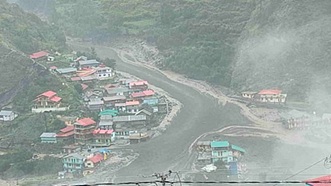Uttarakhand News
Uttarakhand, the northern Himalayan state of India often referred to as “Devbhoomi” or the Land of the Gods, witnessed yet another tragic reminder of nature’s fury on August 5, 2025. In a shocking turn of events, a devastating flash flood swept through the picturesque Dharali village near Gangotri in the Uttarkashi district, leaving behind a trail of destruction, death, and despair. The calamity unfolded so rapidly that residents and tourists had mere moments to react, and within minutes, a vibrant village turned into a scene of chaos and debris.
Known for its serene beauty, snow-clad peaks, sacred shrines, and eco-sensitive zones, Uttarakhand has repeatedly been the epicenter of natural disasters, and this latest incident once again exposed the fragility of life in the face of increasingly unpredictable and severe weather events.
Table of Contents
The Unexpected Cloudburst That Changed Everything
The Origin and Force of the Disaster
The disaster began around 1:45 PM on August 5, 2025, when the region was struck by a sudden and intense cloudburst. Though the exact rainfall intensity did not reach the conventional benchmark of over 100 mm in an hour typically used to define a cloudburst, the sheer volume of water cascading down the mountains was more than enough to cause destruction. The upper catchment of the Kheer Ganga River could not withstand the torrent, triggering a powerful and fast-moving mudslide.
As the water and debris gathered speed and force, it surged downward, engulfing everything in its path. Homes, shops, hotels, and even parts of the Indian Army’s Harsil camp were swept away. The Dharali village bore the brunt of this sudden surge, leaving behind scenes reminiscent of the 2013 Kedarnath disaster.
The Destruction in Dharali and Beyond
The flash flood hit with such ferocity that within moments, over 40 structures were obliterated. Among them were hotels, homestays, dhabas, and shops that catered to tourists and pilgrims heading toward the Gangotri Dham. It wasn’t just buildings that were lost—vehicles were overturned, power poles were uprooted, and the roads leading in and out of the area became impassable. Even the National Highway near Sukki Top was damaged, effectively cutting off access to the entire zone. The normally peaceful Harsil Valley, a favorite of trekkers and spiritual seekers, was now covered in a thick layer of silt, debris, and destruction.
Loss of Lives and Widespread Despair
Human Tragedy at the Heart of the News
The worst aspect of this disaster, as with any such tragedy, was the loss of human life. At least four people were confirmed dead, and over 100 were reported missing in the initial hours following the flood. These numbers were feared to rise as rescue operations continued. Among the missing were not only residents and tourists but also soldiers stationed at the army camp in Harsil. It was reported that nine Indian Army personnel had gone missing, with only two being rescued in the initial hours. Families waited in agony for news of their loved ones, while emergency services struggled to access remote areas due to blocked routes and harsh weather conditions.
Infrastructure and Environmental Collapse
The flash flood also caused severe infrastructure damage. Essential services like electricity, communication, and water supply were disrupted. Over 163 roads, including five national highways, were blocked across the state. The Indian Army’s helipad at Harsil was badly affected, which further complicated rescue and relief efforts. The local ecosystem suffered tremendously. Trees were uprooted, riverbanks collapsed, and debris blocked natural water flow. The long-term ecological impact of this disaster is expected to be profound, especially in a region already battling climate change and unsustainable development.
Immediate Response by Rescue Forces
Swift Mobilization of Rescue Agencies
In the face of such an enormous tragedy, the Indian government, local authorities, and armed forces sprang into action. Teams from the State Disaster Response Force (SDRF), National Disaster Response Force (NDRF), Indo-Tibetan Border Police (ITBP), and Indian Army’s Ibex Brigade were mobilized swiftly. Despite blocked roads and poor weather, three teams of NDRF—each consisting of around 35 personnel—were deployed to the site. Two of these teams were airlifted from Dehradun. Cadaver dogs were also brought in to help detect bodies trapped under debris. In a situation where every minute could save a life, these units worked tirelessly, often in hazardous conditions.
Helicopters and Evacuations
The Indian Air Force positioned helicopters such as Chinooks, Mi-17 V5, and ALHs on standby for evacuation and supply drops. Unfortunately, heavy rain and low visibility initially hampered aerial operations. However, when the weather cleared slightly, helicopters began evacuating stranded villagers, tourists, and army personnel. More than 130 people were rescued in the first 24 hours. Those trapped were provided food, water, and emergency medical attention. Temporary relief camps were established at nearby schools and government buildings, offering shelter and hope in the wake of such devastation.
The Government’s Role in Managing the Crisis
Administrative and Financial Action
Chief Minister Pushkar Singh Dhami, upon returning from a scheduled tour, rushed to the disaster site and chaired emergency meetings with key officials. He directed a full-scale rescue and relief operation and approved the release of ₹20 crore from the state disaster fund for immediate relief. The government also deployed medical teams and ensured that food packets, blankets, and necessary items were airdropped to inaccessible areas. In addition, arrangements were made to shift affected families to safer areas and provide psychological counseling to those traumatized by the experience.
Support from the Central Government
The central government, including Prime Minister Narendra Modi and Home Minister Amit Shah, expressed deep condolences and promised all necessary assistance. The Prime Minister monitored the situation closely and directed the Ministry of Home Affairs and Defence to coordinate with Uttarakhand’s administration for rapid deployment of resources. The Indian Army’s expertise in high-altitude and remote area operations played a crucial role in reaching the worst-hit zones.
Climatic and Environmental Factors Behind the Disaster
Climate Change and Unpredictable Rainfall
This flash flood, like many in recent years, has been attributed to increasingly erratic weather patterns caused by climate change. Uttarakhand, with its sensitive mountain ecology, is especially vulnerable. The Indian Meteorological Department had issued red and orange alerts for several days leading up to the disaster. However, the recorded rainfall in the Dharali area did not meet traditional cloudburst criteria, leaving experts puzzled.
Some now believe a glacial lake outburst flood (GLOF) or a sudden water release from upstream might have triggered the deluge. This unpredictability underlines the importance of improving early warning systems and implementing climate-resilient infrastructure.
Unsustainable Development and Its Consequences
Over the years, the push for tourism and infrastructure development in Uttarakhand has led to rampant deforestation, unregulated construction on steep slopes, and the narrowing of river channels. Experts have long warned that such practices disturb the natural drainage systems and increase the risk of disasters. The 2025 flash flood once again confirms that without strict environmental regulation and sustainable planning, the region remains at constant risk. The debris from destroyed buildings, roads, and vehicles also contributes to pollution and long-term damage to river systems and local wildlife.
Long-Term Impact and Urgent Needs
Rebuilding and Rehabilitation
The immediate challenge after the disaster is the rehabilitation of displaced families. Temporary shelters, food supplies, medical care, and financial compensation are being arranged by the state government. However, rebuilding homes, schools, roads, and livelihoods will take months, if not years. Special attention will need to be given to the tourism sector, which is the economic backbone of the region. The destruction of homestays, hotels, and pilgrimage routes will have a severe economic impact on thousands of local families who depend on visitors for income.
Need for Better Planning and Policies
This disaster must serve as a wake-up call for both state and central authorities. Policies around urban planning, road construction, and tourism development in ecologically sensitive areas need urgent revision. Early warning systems must be upgraded, and local communities must be educated about evacuation drills and emergency response. A balance between development and environment is no longer optional—it is essential for the survival of communities in Himalayan states like Uttarakhand.
Conclusion: A Reminder of Nature’s Power
The tragic flash flood in Uttarkashi has once again highlighted the power of nature and the vulnerability of human settlements in high-risk zones. While the bravery of the rescue teams and the swift response of the government are commendable, the true measure of progress will be how we prepare for such events in the future. Uttarakhand must now embark on a path of sustainable growth, backed by science, environmental consciousness, and a firm commitment to preserving the fragile Himalayan ecosystem.
The loss of lives, homes, and heritage cannot be undone, but the lessons learned must lead to policies that protect the people of this sacred land from future calamities. Only through resilience, preparedness, and respect for nature can Uttarakhand truly find peace and safety amidst its awe-inspiring mountains and rivers.






